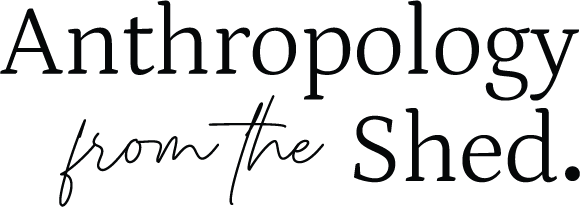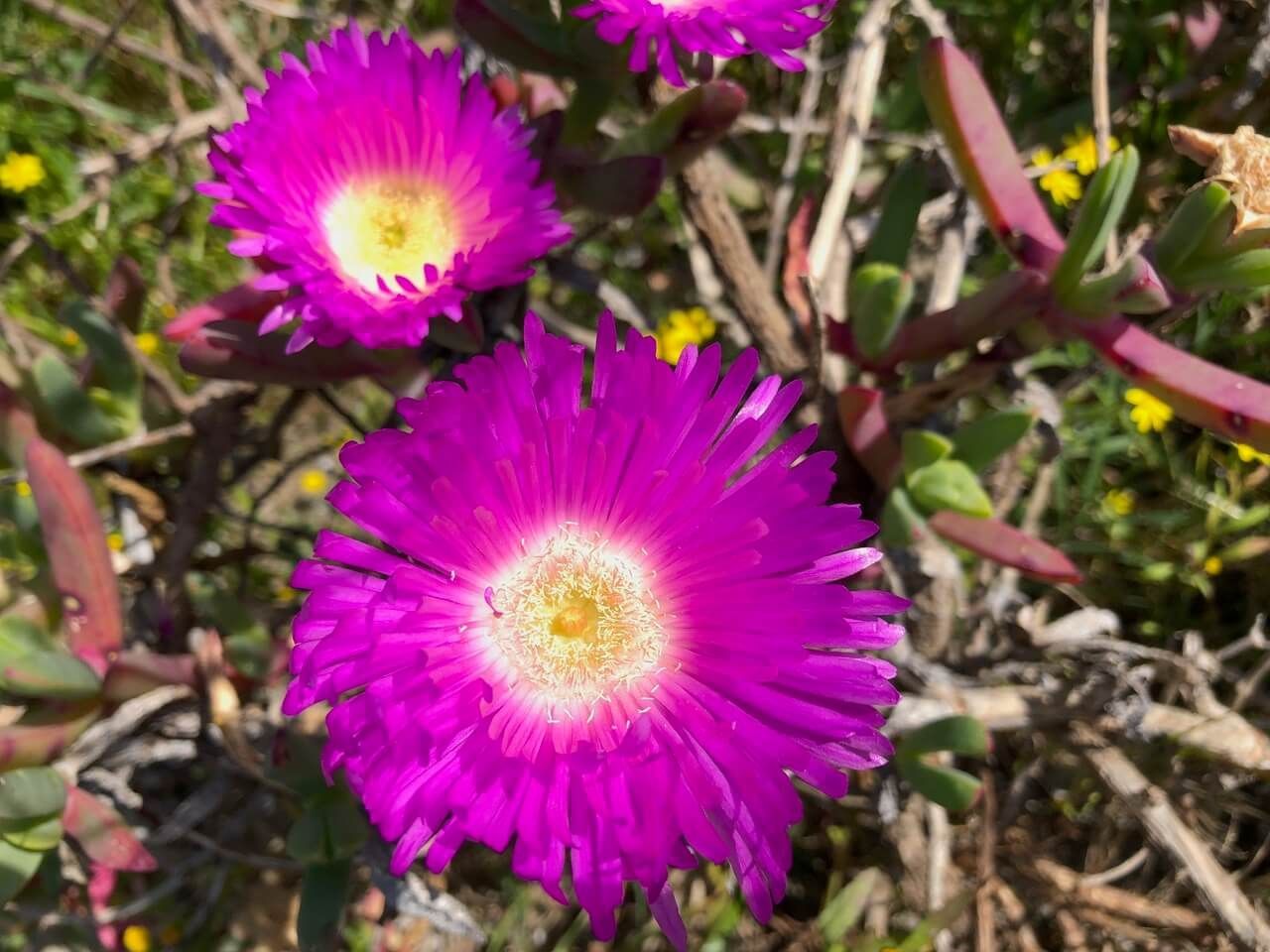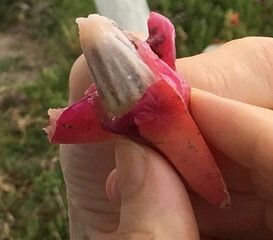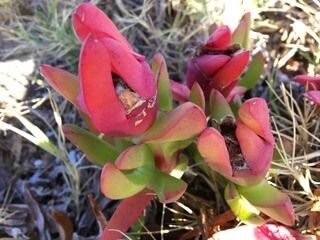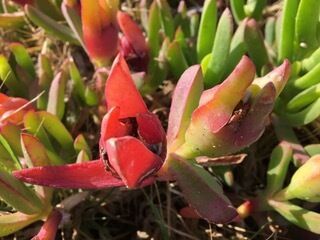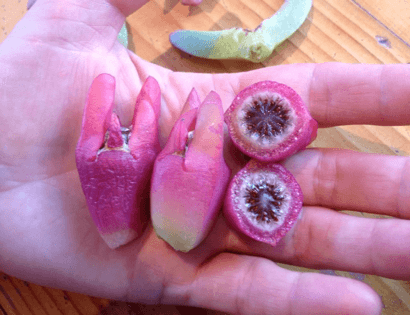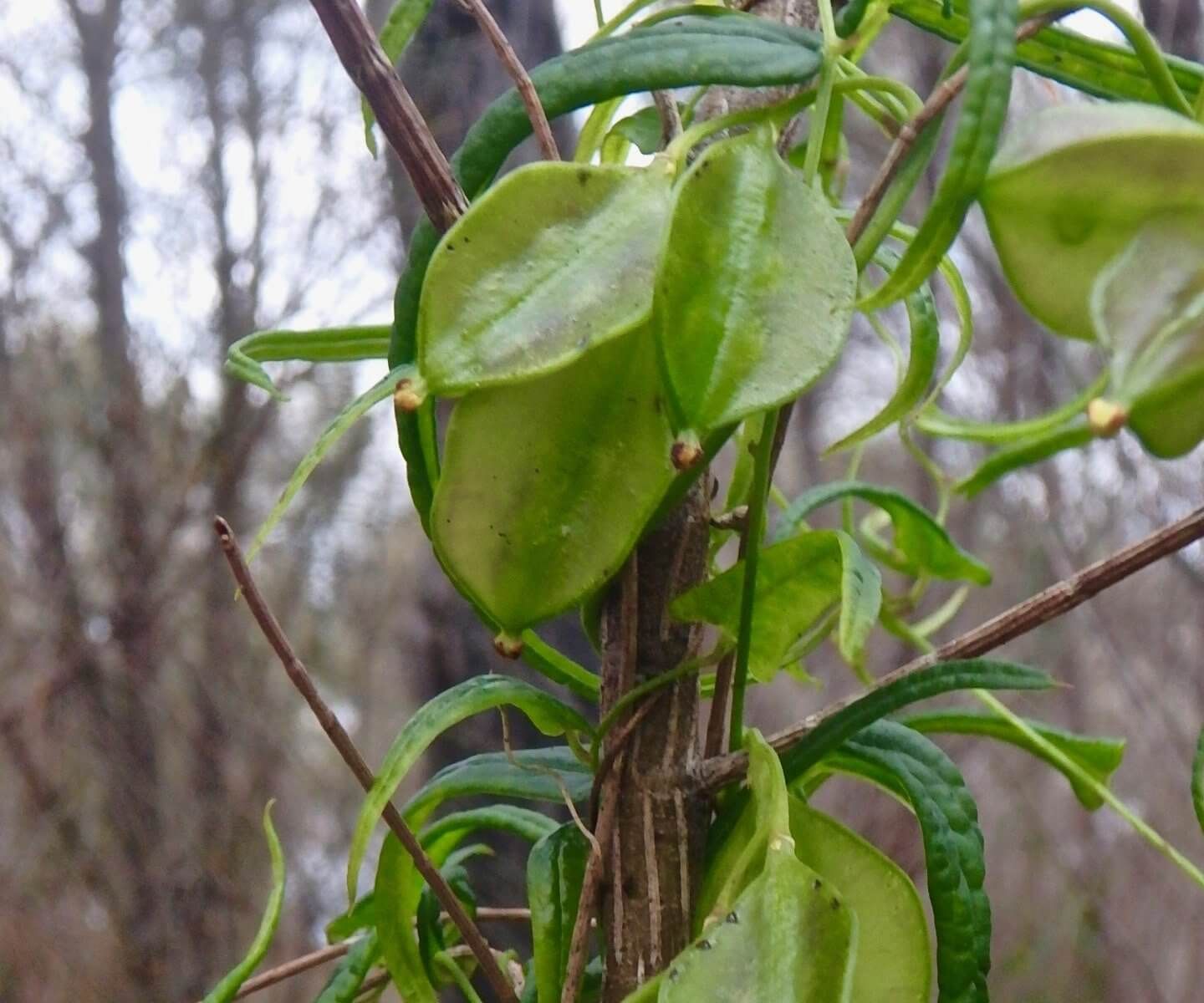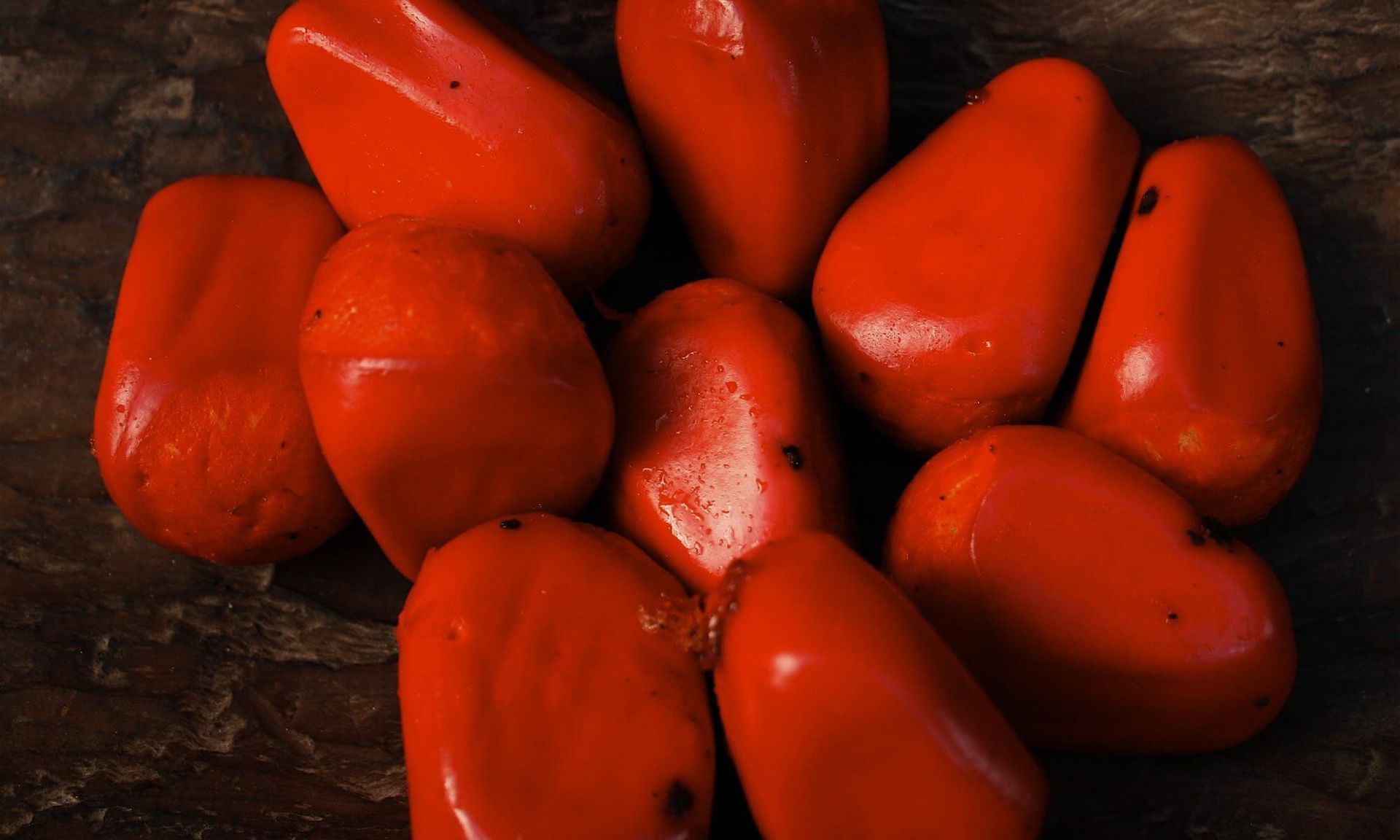Will this ancient succulent herb reveal a medical miracle?
Will this ancient succulent herb reveal a medical miracle?
By Ken Macintyre & Barb Dobson, Research anthropologists
The Noongar spokesman pointed to the purplish-red fruit of the pigface (Carpobrotus virescens) growing on the dunes at Swanbourne and stated that
‘in summer the ripe fruit of the johnny coolbungs was used just like a salt tablet. It quenched your thirst, gave you energy and was a good snack’
“Pigface” is the common name of the prostrate shrub or creeper which grows prolifically on the sandy and rocky coastline and limestone belt of southwestern Australia. Its Noongar names include golbooga (Lyon 1833), kolbogo (Grey 1840: 65; Moore 1842), golboy (Grey 1841) and “johnny koolbung” (Bropho 1980: 9). According to Symmons (1841), the Protector of Aborigines, kolbogo refers to the large Hottentot fig while manbibi refers to the small Hottentot fig. It was also known as majeruk (Grey 1840: 77). 1
Early colonial references to Mesembryanthemum or ‘Hottentot fig’ – named after its South African counterpart – suggest native as well as naturalised species of Carpobrotus. Their identification to species is often vague and unclear.1 See Appendix for glossary of Noongar terms for the Carpobrotus and its edible fruit.
Our native coastal pigface (Carpobrotus virescens) known as kolbogo has bright pink-purplish flowers (see Plate 1). It can often be seen growing on coastal dunes alongside Carpobrotus edulis – an invasive species originating from South Africa – which has large musty scented yellow flowers that turn pale pink with age (Plate 2). Marchant (1987: 77) notes that: ‘The species appears occasionally to hybridise with C. virescens…. C.edulis usually has much larger flowers than C. virescens and also differs in a number of other measurements.’ 2
The colour of the fruit of C. edulis according to Marchant et.al. (1987: 77) is ‘dull yellowish’ whereas the fruit of our native species, both coastal and inland, is red or purplish-red when ripe. The fruit of the native species is smaller than introduced species. All Carpobrotus bear esculent fruit as the genus name implies (Greek carpos, fruit + brotos, edible). The Latin name edulis also means ‘edible.’
The earliest European reference to native Carpobrotus fruit in south-western Australia is by Captain Phillip Parker King on the shores of Oyster Harbour in Albany in 1818 when he records in his diary:
‘The Mesembryanthemum noticed yesterday being in fruit on the sandy shore I gathered ripe seeds of it.’ (21st January 1818)
A thirst quenching fruit
Carpobrotus is a summer fruit which in its ripened state contains numerous small dark brown seeds surrounded by a white pulpy mixture with a sticky consistency (see Plates 3 and 9-13). The fruit can be easily peeled or squeezed out from the base using one’s fingers. It is highly palatable and has a juicy and mucilaginous texture, tasting something between a strawberry and a fig with a slight salty aftertaste. In the traditional Noongar diet it provided a source of moisture, salt and plant sugars or carbohydrate and helped to stave off thirst and prevent dehydration. It acted similarly to modern day electrolytes – replenishing the body’s essential salts.
Drummond (1842) refers to its thirst-quenching qualities:
‘several species of Mesembryanthemum which bear esculent fruits, but, like Cape Hottentot Figs, which we have naturalised about Clarence, and elsewhere, they are generally shy bearers and when the fruit is produced it is so enveloped with fleshy leaves, full of saline juice, that the flavour is generally spoiled in eating. When out last summer, collecting seeds on the bank of the Salt River, about 20 miles east of Toodyay, I found a species of Mesembryanthemum covered with yellow fruit about the size of a goose-berry, and I think it little inferior, as a fruit, to the English goose-berry. I was in want of water and ate freely of the fruit, and I think it is well worthy of being introduced and cultivated in our gardens. ‘(Letter No. 3 to the Enquirer, 13th July 1842).
It would seem that the yellow fruit to which Drummond is referring is probably that of the introduced Carpobrotus edulis for the native ‘Inland pigface’ (Carpobrotus modestus) found in southwestern Australia, including at Toodyay and further east, has small purplish-pink flowers and purple fruit. Moore (1842: 52) records the name in the Toodyay dialect as metjarak. We grow it on our property at Toodyay where it thrives as a fire-retardant and drought, frost and salt -tolerant ground creeper. It is an easy-to-grow plant with attractive pink-purple flowers in spring, succulent green leaves and abundant fleshy fruit with an interesting salty-sweet taste. We grow our own plants from cuttings and they make very attractive trailing pot plants. We agree with Drummond (1842) that the plant ‘is well worthy of being introduced and cultivated in our gardens.‘
Carpobrotus fruit were, and in some cases still are, much relished by Noongar people. Robert Bropho (1980) describes how as a child living at the Swanbourne fringe-dwellers camp in the 1940’s they used to eat the Carpobrotus fruit that grew wild around their camp. He refers to:
‘Johnny Coolbungs, like a wild fig growing in the ground, in the face of the ground, we used to eat them, we used to love them. I’d eat them now if I saw them around.’ (Bropho 1980:9).
Bird and animal predation on kolbogo fruit and leaves
Carpobrotus as a prostrate perennial shrub provides a natural refuge for small animals and reptiles. When it forms part of the coastal dune ecosystem its succulent fruits provide a welcome source of moisture in the hot summer months, not only for humans but also for bobtail lizards, snakes and frugivorous birds. Traditionally the leaves, flowers and fruits of this plant were predated upon by quokkas, kangaroos, Western brush wallabies and tamars which in turn became the food of the human hunters. The slow moving purple-tongued yorna or bobtail lizard (Tiliqua rugosa) commonly attracted to the ripe fleshy fruit of kolbogo was also considered a valuable food and medicine. Like other seasonal animal and bird competitors for the fruit these also became a readily available source of protein and fat to Noongar people. We have already noted in our Banksia paper how possums and parrots predating on the flower nectar became valued human food http://anthropologyfromtheshed.com/project/the-consumption-of-banksia-nectar-in-traditional-noongar-society/ and in a separate paper how bandicoots, possums, bobtail lizards, native rats and other animals found predating on ripe Macrozamia fruit “sarcotesta” became a much valued complementary protein catch for the bayoo harvesters http://anthropologyfromtheshed.com/project/the-ancient-practice-of-macrozamia-pit-processing-in-southwestern-australia/
We could find no early ethnohistorical accounts of Noongar people consuming the leaves of pigface or kolbogo mungara as a food. However, like with many other indigenous foods this absence of documented evidence does not necessarily mean evidence of absence for Eyre who travelled overland from Adelaide to King George Sound in 1840-1841 states:
‘The thick pulpy leaf of the mesembryanthemum is in general use in all parts of Australia which I have visited, and is eaten as a sort of relish with almost every other kind of food…. It is selected when the full vigour of the plant begins to decline and the tips of the leaves become red, but before the leaf is at all withered. The fruit is used both when first ripe and also after it has become dried up and apparently withered. In each case it has an agreeable flavour and is much prized by the natives.’ (Eyre 1840-41, Project Gutenberg ebook 2013)
The Aboriginal inhabitants of the Grampians and the Victoria Ranges in Victoria according to Wilhelmi (1861: 172-173 cited in Clarke 2013: 101) used the leaves of pigface to salt their meat. The leaves according to Low (1989: 59) are edible but ‘there is sometimes an irritating aftertaste.’ Vennavaram (2007:5) in his thesis from the University of Tasmania notes that the leaves of Carpobrotus edulis 3
‘are also edible and taste like pickled cucumber.’
There are numerous references to the early white settlers boiling the leaves and using them as a green vegetable and a source of vitamin C to prevent scurvy. They also made jam from the fruit – an innovation that was readily adopted by some Noongar families who found that by mixing native fruit, sugar and water made a tasty jam. Quandong jam is another example of the indigenisation of a colonial food preparation.
Medicinal Uses – Noongar anecdotal accounts
Anecdotal sources indicate that Noongar people used the fruit and leaves of Carpobrotus for medicinal purposes. One Elder pointed out to us during a field survey that the succulent fruit could be a laxative and cause a bout of diarrhoea if eaten in large quantities. He stated:
‘It’s as good as Epsom salts.’
The ripe pulpy fruit was also used as a bush medicine to treat chronic diarrhoea by helping to restore fluid balance and nutrients.
A senior female Noongar Elder pointed out while on a field trip with us at Alkimos, north of Perth, discussing “bush medicine” that the saline juice of the leaves of Carpobrotus was believed to be a traditional antiseptic and possessed a mild anaesthetic quality. She likened its soothing effects to aloe vera. The plant’s leaves in a crushed form were used traditionally as a poultice to relieve mild burns, skin irritations and insect bites. She said that sometimes a fine white wood ash from the Banksia was added to the gelatinous poultice to give it a soothing paste-like quality. She stated that it was more effective than calamine lotion.
Australian and South African ethnomedical research into the efficacy of Carpobrotus extracts
There has been considerable scientific research into the beneficial effects of the leaf extract of Carpobrotus rossii which is native to Western Australia, South Australia, Victoria and Tasmania. This species, according to Florabase, is found in the Carnarvon/ Shark Bay area.
Vennavaram (2007: 127) from the University of Tasmania who analysed the chemical components and pharmaceutical properties of three species of Carpobrotus (C. rossii, C. edulis and C. aequilaterus) reported that ‘the plant juice and methanolic extract contained flavonoids, tannins and carbohydrates’ and that
‘The antioxidant activity of Carpobrotus species is significantly potent and a further investigation of the antioxidant compounds and their potential therapeutic applications warrant investigation.’
A later study by Geraghty et al (2011) from the University of Tasmania notes that:
‘Carpobrotus rossii (CR) has a history of use as a food and therapeutic agent by Australian indigenous peoples and early European settlers and is believed to contain a number of pharmacologically active polyphenolic compounds…. Oxidation of low density lipoprotein (LDL), platelet aggregation, and inflammation contribute to the development and progression of atherosclerosis. The aim of the present study was to investigate the antioxidant, antiplatelet and anti-inflammatory activity of CR extract using human blood components.’
This study found that the leaf of Carpobrotus rossii
‘has significant in vitro antioxidant, antiplatelet and, potentially, anti-inflammatory activity.’ (Geraghty et al 2011: 97)
Scientific studies have been carried out in South Africa on Carpobrotus edulis to assess the therapeutic efficacy of its leaf extract in treating a range of conditions, including tuberculosis:
‘the leaf of Carpobrotus edulis was reported to have showed significant difference for the treatment of TB and as an immune booster for HIV patients in Nkonkobe Municipality [South Africa].’
Springfield et al (2003) assessed the therapeutic efficacy of leaf extracts from two other South African species – Carpobrotus muirii and Carpobrotus quadrifudus sometimes used by tribal healers interchangeably with C. edulis to treat a range of conditions including chronic infections. The results of their study confirmed that these species also possessed pharmacologically powerful anti-bacterial properties and in a subsequent study Springfield and Weitz (2006) found that Carpobrotus mellei also possessed antimicrobial properties. They note:
‘This scientific information can serve as an important platform for the development of inexpensive, safe and effective natural anti-infective medicines.’ (Springfield et al 2003).
Springfield and Weitz (2006: 1292) comment that the bioactive compounds isolated by Van der Watt et al (2001) were
‘identified as flavonoids [and] it is likely that the phytochemical class, flavonoids, may be the sole contributor to the bioactivity in the genus Carpobrotus.’
They further point out that
Flavonoids have been associated with a range of pharmacological activities (Hostettman et al.,1995), modulation of immune cell function, hepatoprotection, anticarcinogenicity and antiviral activity (Middleton and Kandaswami, 1993).’ (Springfield and Weitz 2006: 1292).
To our knowledge there have been no scientific studies carried out on the chemical and pharmacologically therapeutic properties of our own local native coastal and inland species of Carpobrotus found in southwestern Australia. These are C. virescens (coasal) and C. pulchella ms (coastal) and C. modestus (inland pigface).
Noongar people have been aware for thousands of years of the medicinal and nutritional qualities of this plant. However, it is only now that we are starting to acknowledge the natural therapeutic benefits that this plant may provide.
With respect to our anecdotal references to the medicinal qualities of the fruit and leaves of Carpobrotus in Noongar culture, we would caution their usage without consultation with an experienced indigenous practitioner.
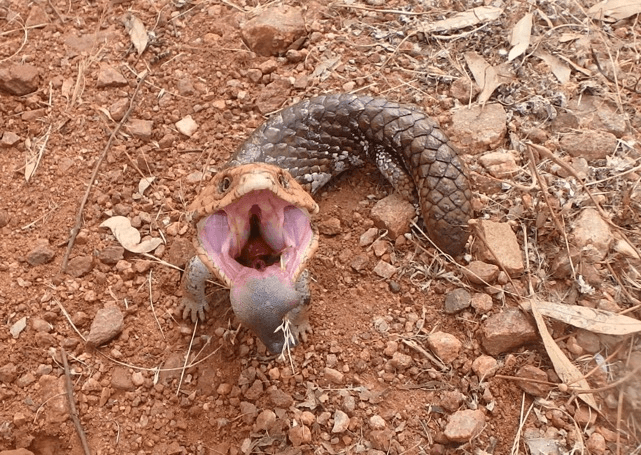
ANNOTATIONS
I. Grey records kolbogo (1840: 65) and majeruk (1840: 77) as the Noongar names for ‘the Hottentot fig’ in southwestern Australia. Majeruk is also rendered in the ethnohistorical sources as majerak, metjarak and mejarak (see Appendix for a glossary of Noongar terms ). There is an attempt by Moore (1842: 42, 53) to identify kolbogo and metjarak to a particular species – Mesembryanthemum equilateralis or what he calls ‘the Hottentot fig-plant.’ This species’ name, according to botanical sources, is synonymous with Carpobrotus aequilaterus, which refers to a widely naturalised species of “angular pigface” found throughout coastal southwestern Australia where it is considered an invasive weed originating from South Africa (also South America, hence its name “Chilean fig”). It is impossible to ascertain whether Moore is in fact referring to the introduced species or the native Carpobrotus. The Noongar would have eaten all species which had edible fruit, native and naturalised. As highlighted in our other papers, the European-derived Linnaean speciation model had little if any relevance to a traditional Aboriginal hunter-gatherer-cultivator economy which had evolved over many thousands of years its own practical and utilitarian survival-based taxonomy and nomenclature systems.
2. Local botanist Greg Keighery points out that native Carpobrotus are generally dioecious (that is, separate male and female plants): the native female plants have small pale pink flowers, smaller petals than the male and ‘a white centre with a prominent stigma in the centre.’ The native male plants ‘have larger flowers that are bright pink,’ have longer petals and are ‘yellow in centre (because of pollen filled anthers). By contrast the introduced C. edulis is a hermaphrodite. Keighery further points out that hybrids between C. edulis and C. virescens ‘have hermaphrodite flowers that are pale pink, larger than C. virescens.‘ For further insights see Keighery’s paper at http://cambridgecoastcare.com.au/wp-content/uploads/2015/05/P140A-2014-x-Greg-Keighery-Carpobrotus-SNEC-REPORT2.pdf
3. Vennavaram (2007:5) points out that Carpobrotus edulis is known as the “sour fig” in South Africa (Venning, 1984) and it bears ‘a figlike brown fruit that is edible and can be used as a preserve.’ His thesis titled ‘Investigation of chemical components and pharmaceutical potential of Carpobrotus species’ provides valuable insights into the chemical and pharmaceutical properties of three Carpobrotus species (C. rossi, C. edulis and C. aequilaterus) found in Tasmania
BIBILOGRAPHY
Bropho, R. 1980 Fringedweller. Sydney: Alternative Publishing Cooperative.
Drummond J. 1842 Letter No. 3 to the Inquirer, 13th July.
Eyre, Edward John 1840-1841 Journals of expeditions of discovery into Central Australia and overland from Adelaide to King George’s Sound. Vols 1 & 2. London: T & W Boone. A Project Gutenberg eBook. Posted 2013. Produced by Colin Choat.http://gutenberg.net.au/ebooks/e00048.html#ch-2-2
FloraBase 2017 The Western Australian Flora. Western Australian Herbarium ‐ Department of Environment and Conservation. Available at https://florabase.dpaw.wa.gov.au
Geraghty,D.P., Ahuja,K.D., Pittaway,J., Shing,C., Jacobson, G.A., Jager,N., Jurkovic,S., Narkowicz,C., Saunders,C.I., Ball, M., Pinkard, A., Vennavaram, R.R., and M.J. Adams 2011 ‘In vitro antioxidant, antiplatelet and anti-inflammatory activity of Carpobrotus rossii (pigface)’ Journal of Ethnopharmacology, March 8, 134 (1): 97-103. Epub 2010. Abstract.
Grey, G., 1840 A Vocabulary of the Dialects of South Western Australia. London: T. and W. Boone.
Keighery, G.J. 2014 ‘Confusion with Carpobrotus on Perth’s beaches.’ A report for Stirling Natural Environment Coastcare Department of Parks and Wild Life. November. http://cambridgecoastcare.com.au/wp-content/uploads/2015/05/P140A-2014-x-Greg-Keighery-Carpobrotus-SNEC-REPORT2.pdf
Low, Tim 1989 Bush Tucker: Australia’s Wild Food Harvest. Pymble, New South Wales: Angus & Robertson.
Low, Tim 1990 Bush Medicine: A Pharmacopoeia of Natural Remedies. North Ryde: Angus and Robertson.
Lyon, R.M. 1833 ‘A Glance at the Manners, and Language of the Aboriginal Inhabitants of Western Australia; with a short vocabulary’. In N. Green (Ed.) Nyungar – The People: Aboriginal customs in the southwest of Australia. Perth: Creative Research Publishers.
Marchant, N.G.; Wheeler, J.R.; Rye, B.L. Bennett, E.M.; Lander N.S. and T.D. Macfarlane 1987 Flora of the Perth Region. Part One.
Moore, G.F., 1842 A Descriptive Vocabulary of the Language in Common Use Amongst the Aborigines of Western Australia. London: W.S. Orr and Co. Hard copy.
Omoruyi, B.E.; Bradley, G. and A. J. Afolayan 2012 Journal of Medicinal Plants Research Vol. 6 (19), pp. 3603-3608, 23rd May.
Vennavaram, R.R. 2007 Investigation of chemical components and pharmaceutical potential of Carpobrotus species. University of Tasmania. B.Pharm, MPharm Sci. Submitted in fulfilment of the requirements for the degree of Master of Pharmacy (Research Higher Degree) https://eprints.utas.edu.au/5086/1/whole_vennavaram_thesis.pdf
Springfield, E.P., Amabeoku, G.; Weitz,; F. Mabusela, W. and Q. Johnson 2003 “An assessment of two Carpobrotus species extracts as potential antimicrobial agents.” Phytomedicine: International Journal of Phytotherapy & Phytopharmacology, vol. 10, no. 5, 2003, p. 434+
Symmons, Charles 1841 Grammatical Introduction to the study of the Aboriginal languages of Western Australia. Perth: Western Australian Almanack.
Wheeler, Judy; Marchant, Neville; Lewington, Margaret; Graham, Lorraine (2002). Flora of the south west, Bunbury, Augusta, Denmark. Volume 2, dicotyledons. Australian Biological Resources Study. Canberra.
APPENDIX 1: Glossary of Noongar terms for Carpobrotus and its fruit
‘kolbogo – the Hottentot fig – a species of Mesembryanthemum.’ (Grey 1840: 65)
‘kolbogo – the Hottentot fig (large)’ (Symmons 1841: vii)
‘kolbogo – Mesembryanthemum equilateralis; the Hottentot fig-plant. The inner part of the fruit is eaten by the natives. It has a salt sweetish taste.’ (Moore 1842: 43).
‘kolbogo mungara’ (Grey 1840: 65) or ‘kolbogo mangara’ (Moore 1842: 53) – ‘the leaves of the Hottentot fig.’
‘majeruk – the fruit of the Hottentot fig, a species of Mesembryanthemum.’ (Grey 1840: 77)
‘majerak – The small Hottentot fig. (Mountain dialect). The fruit is eaten by the natives.’ (Moore 1842: 48).
‘metjarak – ‘Mesembryanthemum equilateralis; Hottentot fig (Toodyay dialect)’ (Moore 1842: 52)
manbibi – ‘the small Hottentot fig.’ (Symmons 1841: vii; and Moore 1842: 49).
